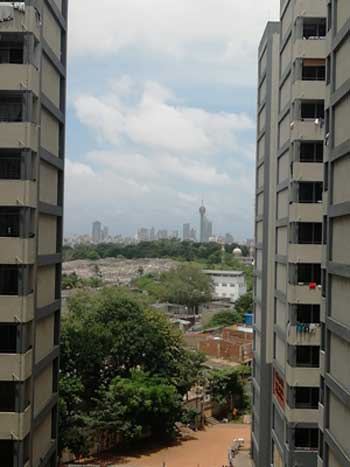‘High life’ in a high-rise in Colombo

A government housing scheme: A far cry from the promised “Raja maligawa”
I was travelling in the lift in Crystal Court (pseudonym for my fieldsite in a high-rise housing project) on a Sunday evening, when the lift lurched to a stop. We were suddenly suspended in mid-air and warmth flooded the lift. I counted thirteen or fourteen people in the lift, all getting increasingly agitated. A woman carrying a baby frantically screamed at Chandana Uncle (my landlord), who was standing closest to the door, “Ring the bell, ring the bell!”
Flustered, he started pressing all the buttons at once, desperately searching for the emergency bell. When this didn’t work, he started pushing at the lift doors in both directions trying to force them open. What was only two to three minutes, seemed like an hour, as chaos ensued in the lift. The heat increased palpably.
After about five minutes, the lift stuttered to life again and reached the ground with a painful groan. We stumbled out, relieved. Some vaguely indicated to those waiting impatiently outside the lift that something was wrong, while the others scuttled out as soon as possible and went on their way.
This vignette describes an incident at the onset of my research project conducted from September 2019 to January 2021 in a high-rise complex in Colombo, exploring everyday life in a government-owned housing project constructed under the Urban Regeneration Project.
This was one among many encounters of everyday life in Crystal Court. Crystal Court residents had been relocated from their homes in different urban wattas (urban settlements) across Colombo. Relocation was part of governmental initiatives to ‘eliminate slums and shanties’ and relocate 66,000-70,000 ‘underserved households’ from ‘prime land’ and utilise the land for more profitable’ purposes.
Government housing projects possessed Sinhala names such as ‘Uyana’, ‘Sevana’ or ‘Pura’ (Gardens, Shade, City), articulating visions of gardens, parks, shady spaces, or magnificent city life which was often far from real life in the housing projects. Predominant usage of Sinhala names for these housing projects was also disconcerting as many residents were non-Sinhala people. However, names of housing projects reflected modernist imaginaries of ‘world-class’ cities pivotal to the government agenda in constructing these flats. I intentionally use an anglicised pseudonym, due to an inability to find a Sinhala equivalent to sufficiently anonymise and represent my fieldsite.
As urban poor communities are regularly stereotyped the pseudonym was essential to protect my research participants. ‘Crystal Court’ also symbolises the multi-faceted nature of my field site. Although highfalutin’ state rhetoric claimed that those living in ‘slums and shanties’ would transition from their palpatha to a palace-like abode (raja maligawa), when they were granted a ‘house for a house’ (geyata geyak), my field work focused on the everyday realities in the Urban Regeneration Project.
In the context of the upcoming local government elections, it is crucial to engage in meaningful conversations regarding urban housing and urban community life. Urban regeneration plans have been pivotal in governmental agenda over the past years and urban relocation of communities to high-rises have created multiple disruptions to many urban communities. Hence, it is crucial to consider whether these projects achieve the ‘high life’ envisioned. Meghal Perera’s article (The Sunday Observer 31.03.2025) details the true cost of the Urban Regeneration Project, outlining the crushing economic impact of such projects. However, the 2025 government budget has continued to provide hefty allocations for the Urban Regeneration Project.
In addition, to devastating economic losses, we must seriously consider the social costs of these projects, especially the impact on home and community. While the drive to become like Singapore, London, Paris, or New York has often been a national preoccupation, the social costs and the impact on community and neighbourhood in these cities are undeniable.
Jane Jacobs in her classic The Death and Life of Great American Cities (1961; 2011) critiques prominent urban planners who strove to create modern, urban utopias while attempting to breakdown urban community life in America. Jacobs (ibid) urged city planners to understand that a city was more than economic structures or buildings and that a city must be shaped by the interactions and everyday life of its people. Cernea (1997) in evaluating development projects purportedly implemented for the ‘greater good’, exposed that these schemes often precipitated future losses and resulted in impoverishment, risk, and vulnerability. Roy (2005) in her study on Indian cities, characterised urban development projects as ‘aestheticising poverty’. Hansen and Verkaik (2009) describe similar conditions as ‘structural opacity’ which dresses up the structure, while rendering the poor out of sight.
My study of Crystal Court revealed that despite rhetoric of ‘world-class’ cities, the socio-structural problems of urban working-class communities remained largely unresolved. Everyday Crystal Court experiences often revolved around the lift. Residents embarked and disembarked on various floors, sometimes they manipulated the lift, some ‘held’ the lift for family, friends, and neighbours, others waited impatiently on the ground floor till the lift arrived, people carried their garbage down in the lift, they went about to their everyday lives using the lift. These tense, and even humourous everyday incidents were varied. As depicted in the opening vignette where the lift was momentarily suspended in mid-air, everyday life itself became precarious due to the lift. On some occasions, the lift plunged down with accelerated speed. One woman stated she suffered a miscarriage due to the lift breaking down. On speaking to her family, I asked whether they informed the authorities, but her family said that reporting was futile, and that they ignored this incident.
Often, the lift was closed in the event of fire risks and other crises. Multiple problems arose due to delays with the lift, especially for vulnerable groups, i.e. the elderly, children, people with health issues and disabilities. Many voiced these everyday frustrations claiming, “We can never get anywhere in a hurry” (hadissiyakata kohewath yanna bae). This was evident when a resident from the sixth floor suffered a heart attack. The lift delayed resulting in his family members carrying him down the stairs, finally, resulting in his untimely death. Hence, the lift that embodied visions of modernity, was also a space of disruption and precarity.
My study infers that the Urban Regeneration Project exacerbated the precarious life-worlds of the urban poor in Colombo. However, my argument extends beyond victimhood narratives, vulnerability and impoverishment, a common research finding regarding post-relocation settings. Crystal Court life constructed by the Urban Regeneration Project was complex. Residents adapted to their new mode of transport, life revolved around the lift, which was a new urban space for social interaction, for conflict, for humour, for construction of identity and belonging, a portal to reach home, a multidimensional space that contributed to homemaking and community building.
Although urban regeneration projects were implemented as monolithic projects of modernity, it was evident that this was not a ‘one size fits all’ model. Different residents constructed home in different ways. It was identifying these complexities of home and community that made Crystal Court life both interesting and challenging.
It is these neglected aspects of home and community that must be absorbed into city planning. It is hoped that in the lead-up to the local government elections, city planning would extend beyond mere modernist imaginaries and “world-class” cities narratives and instead engage in efforts to construct stronger and stable homes and communities in Colombo.
(Avanka Fernando is based at the Department of Sociology, University of Colombo. Her PhD in Social Anthropology was on “High life in a high rise: An ethnography of home and everyday life in a relocation housing project in Colombo, Sri Lanka”)
Searching for an ideal partner? Find your soul mate on Hitad.lk, Sri Lanka's favourite marriage proposals page. With Hitad.lk matrimonial advertisements you have access to thousands of ads from potential suitors who are looking for someone just like you.


